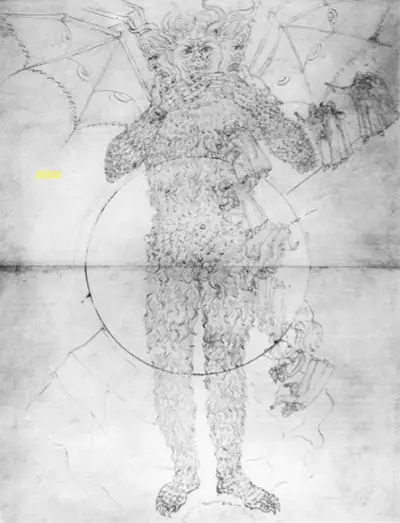 Buy Art Prints Now
Buy Art Prints Nowfrom Amazon
* As an Amazon Associate, and partner with Google Adsense and Ezoic, I earn from qualifying purchases.
This large drawing spanned across two pages and was Botticelli's second depiction of this character
This sketch came from Inferno XXXIV. This draw underlines the full story of Inferno Canto XXXIV and indicates Lucifer's position in Hell. You will find here the story of Dante and Virgil's fall into Hell.
This frightening creature has three heads and is more commonly known as Satan. In Dante's Inferno, Satan's three heads are joined by bat-like wings which helps to get across the theme of terror and desperation for those who end up in hell. His wings are also significant in that the wind they produce freezes other around and leaves them totally vulnerable.
The key to the three heads is that they mean he is able to consume Judas, Brutus and Cassius all at the same time. Justice prevails for three of the worst individuals that humanity has to offer.
The Emperor of the kingdom dolorous / From his mid-breast forth issued from the ice; /And better with a giant I compare / Than do the giants with those arms of his; / Consider now how great must be that whole, / Which unto such a part conforms itself. / Were he as fair once, as he now is foul, / And lifted up his brow against his Maker, / Well may proceed from him all tribulation. / O, what a marvel it appeared to me, / When I beheld three faces on his head! / The one in front, and that vermilion was;
Lucifer lurks in the last of four rings, Judecca, in the ninth and last circle of hell. Whilst Lucifer has had varying representations within art and literature, most have portrayed him as more powerful than Botticelli has done here. Related artworks include Raphael's St Michael Vanishing Satan and the Baronci Alterpiece. Michelangelo's Fall of Man tells the story of how Satan disguised himself as a snake and tempted Adam and Eve to eat the forbidden fruit.
The most famous painting with the title of Lucifer was actually a modern art piece by Jackson Pollock, but many other famous names from the Renaissance have also addressed similar themes. Hieronymus Bosch's Hell is one of the finest artistic depictions of this dark topic, and it was well suited to this Northern Renaissance master who frequently addressed moral and biblical issues within his work.




